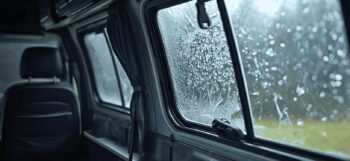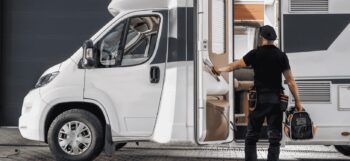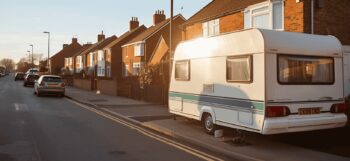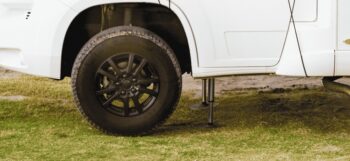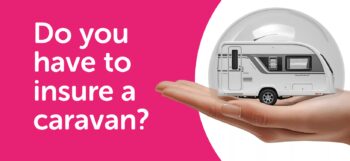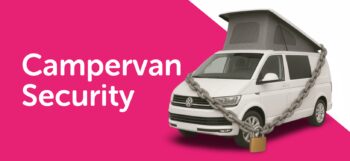Hitching your caravan correctly is crucial. Get it wrong, and you risk fines, damage to your vehicle, your caravan—or worse, an accident. Below, we take you through advised steps to help you avoid potential issues, covering everything from the equipment you need to how to hitch your caravan correctly to your vehicle.

What you need to hitch your caravan
Before you get started, make sure you have all the necessary tools and components to hitch your caravan safely and legally.
Here’s what you’ll typically need:
- Tow vehicle with a compatible towbar: Ensure it’s correctly rated for your caravan’s weight.
- Hitch coupling: This connects securely to the tow ball, which is located at the front of the caravan.
- Safety chains: A legal requirement in some scenarios to prevent total detachment if the hitch fails.
- Breakaway cable: Automatically applies the caravan’s brakes if it becomes disconnected.
- Electrical connection: Powers your caravan’s lights and indicators.
- Jockey wheel: Helps raise and lower the hitch onto the tow ball.
- Stabiliser (if fitted): Improves handling and control while towing.
How to hitch your caravan
Make sure the caravan’s handbrake is on, the corner steadies are raised, and the caravan hitch is positioned slightly higher than your vehicle’s tow ball. Then, follow these step-by-step instructions to safely hitch your caravan.
Step 1: Reverse into position
Carefully reverse your vehicle so the tow ball is directly beneath the caravan’s hitch. If you’re working alone, using a motor mover can make the final adjustments easier and more precise.
Step 2: Connect the breakaway cable
Attach the breakaway cable to your vehicle. If your towbar includes an eyelet, loop the cable through it and clip it back onto itself securely. This cable is a critical safety feature, designed to activate the caravan’s brakes if it detaches.

Step 3: Lower the hitch onto the tow ball
Raise both the stabiliser and hitch levers. Then, use the jockey wheel to lower the caravan’s hitch onto the tow ball by winding it upwards, lowering the caravan’s front end in the process.
Step 4: Confirm the hitch is secure
Continue winding the jockey wheel until the hitch fits snugly over the tow ball. You should hear the smaller hitch lever click down and see the green visual indicator pop out. To double-check it’s properly connected, wind the jockey wheel back down slightly—the rear of the tow vehicle should lift an inch or two if the connection is secure.
Step 5: Stow the jockey wheel
Wind the jockey wheel fully up, ensuring the forks engage with their locating slots. Loosen the clamp, lift the jockey wheel shaft, and secure it safely in its stowed position.
Step 6: Engage the stabiliser
If your caravan is fitted with a stabiliser hitch, push the stabiliser arm down. A green visual indicator should confirm that it’s locked into place.
Step 7: Connect the electrics
Plug in the electrical connector(s) for your caravan’s lights and indicators. If the cable is excessively long, twist it once to keep it from dragging on the road while driving.
Step 8: Check the ATC system (if fitted)
If your caravan includes an AL-KO ATC (Automatic Trailer Control) system, check the indicator light on the A-frame. A green light means the system is functioning correctly. If it shows red, unplug and reconnect the caravan to the vehicle. Contact your retailer or service provider if the red light persists.
Step 9: Fit and adjust towing mirrors
Attach towing mirrors to your vehicle to ensure full visibility. Adjust them so the inner third shows your vehicle, with the remainder providing a clear view of your caravan and the road behind.
Step 10: Perform final safety checks
Before setting off, walk around your caravan and vehicle to do one last check:
- Are all connections secure?
- Are all corner steadies raised?
- Is the handbrake released?
- Are the tyres properly inflated?
Are all doors, windows, and rooflights on the caravan locked?

Safety tips and best practices for hitching a caravan
To stay safe and compliant every time you tow, consider these tips:
- Follow a checklist every time you hitch up: Even if you're experienced, it helps avoid easy-to-miss details.
- Inspect all towing gear regularly: This includes tow balls, couplings, cables, and stabilisers. Look for signs of wear, damage, or rust.
- Never exceed your vehicle’s towing capacity: This covers both the maximum trailer weight and gross train weight, which are listed in your car’s manual. You can check your vehicle manufacturer’s plate gives information about weight limits for your car. Check the car’s handbook if a plate is not fitted*.
- Use towing mirrors to maintain full visibility: These are a legal requirement if your standard mirrors don’t give a clear view behind the caravan. You can be fined up to £1,000 and get 3 penalty points for towing without proper towing mirrors.**
- Keep the caravan noseweight within limits: Too light or too heavy can affect stability and make towing unsafe.
- Distribute weight evenly inside the caravan: Keep heavy items low and positioned over the axle to maintain balance.
Drive cautiously: Increase your braking distance, take corners wider, and avoid sudden manoeuvres.
Check your lights and connections before every journey: This is especially important on longer trips.
You can read the official UK guidance here.
Legal requirements for hitching and towing caravans in the UK
You can be fined up to £2,500, banned from driving and get 3 penalty points for using a vehicle in a dangerous condition. Follow these advised steps to help stay legally compliant.
- Your driving licence must cover towing: Check the DVLA website if you’re unsure what your category allows.
- The combined weight of your car and caravan must not exceed the legal limit: Make sure your vehicle is approved to tow the total weight.
- The caravan must be roadworthy: Lights must work, tyres should be in good condition, and brakes must be fully functional.
- Mirrors must provide a full rear view: Use towing mirrors if your standard ones don’t.
- The breakaway cable must be properly connected: This ensures the caravan’s brakes activate if it becomes detached.
For full details, visit the official UK government guide.
Protect your caravan with specialist caravan insurance from Lifesure
At Lifesure, we know protecting your caravan can help provide peace of mind during your travels. With over 50 years of experience, we offer tailored caravan insurance and RAC touring caravan breakdown cover to help keep you protected on the road.
Get a quote for touring caravan insurance by calling us on 01480 402 460 to speak to our friendly team. You can also manage your policy and send us secure messages through the MyLifesure customer portal.
*Source: https://www.gov.uk/guidance/tow-a-trailer-with-a-car-safety-checks#load-and-weight-limit
**Source: https://www.gov.uk/towing-with-car/trailer-and-towing-equipment
Disclaimer: The sole purpose of this article is to provide guidance on the issues covered. This article is not intended to give legal advice, and, accordingly, it should not be relied upon. It should not be regarded as a comprehensive statement of the law and/or market practice in this area. We make no claims as to the completeness or accuracy of the information contained herein or in the links which were live at the date of publication. You should not act upon (or should refrain from acting upon) information in this publication without first seeking specific legal and/or specialist advice. Arthur J. Gallagher Insurance Brokers Limited trading as Lifesure accepts no liability for any inaccuracy, omission or mistake in this publication, nor will we be responsible for any loss which may be suffered as a result of any person relying on the information contained herein.
FP841-2025



